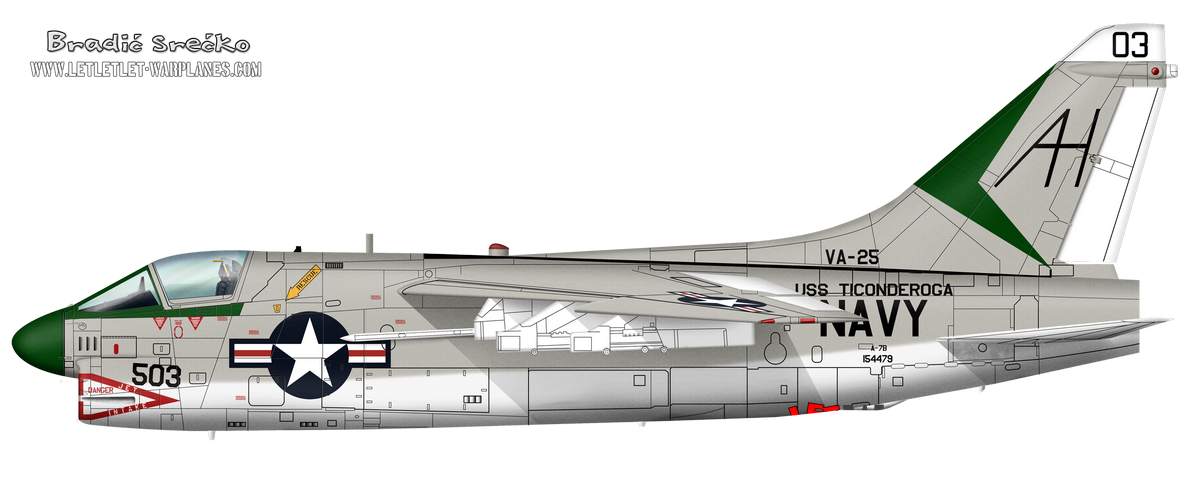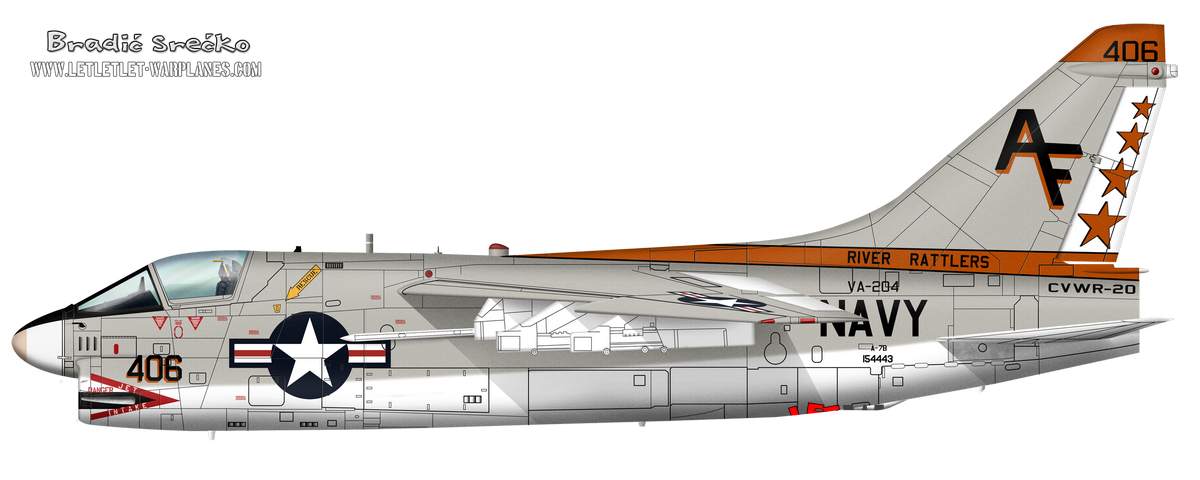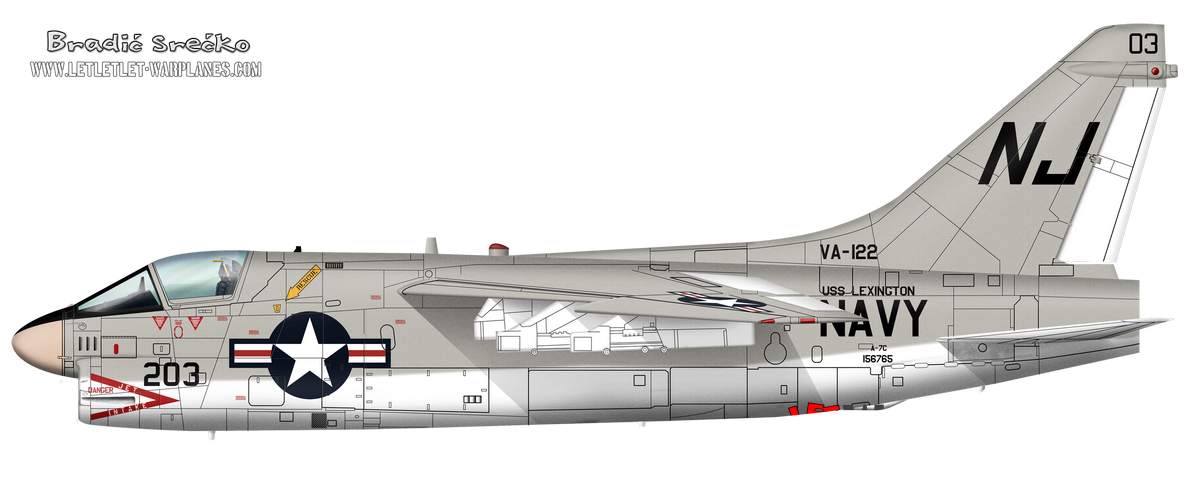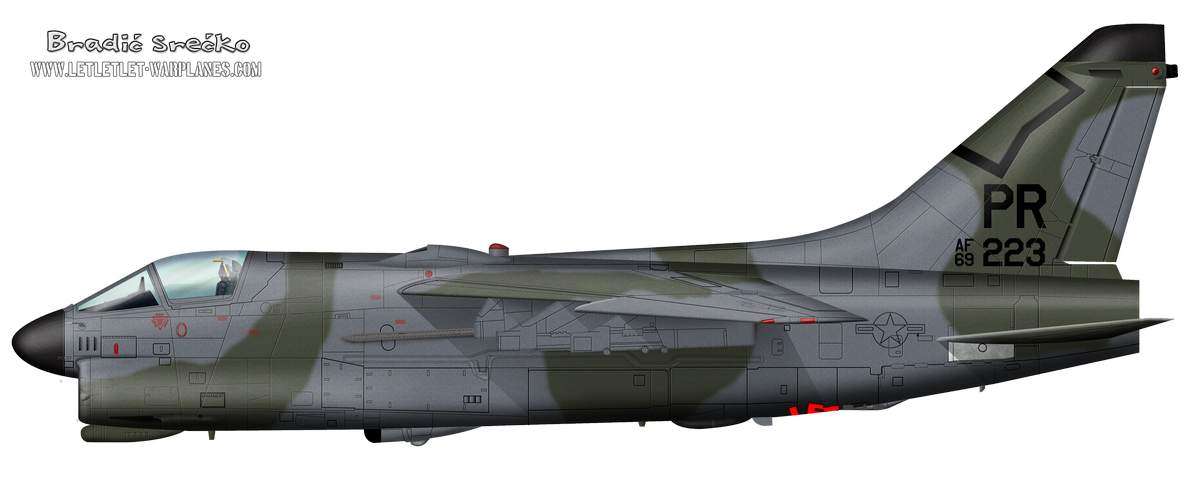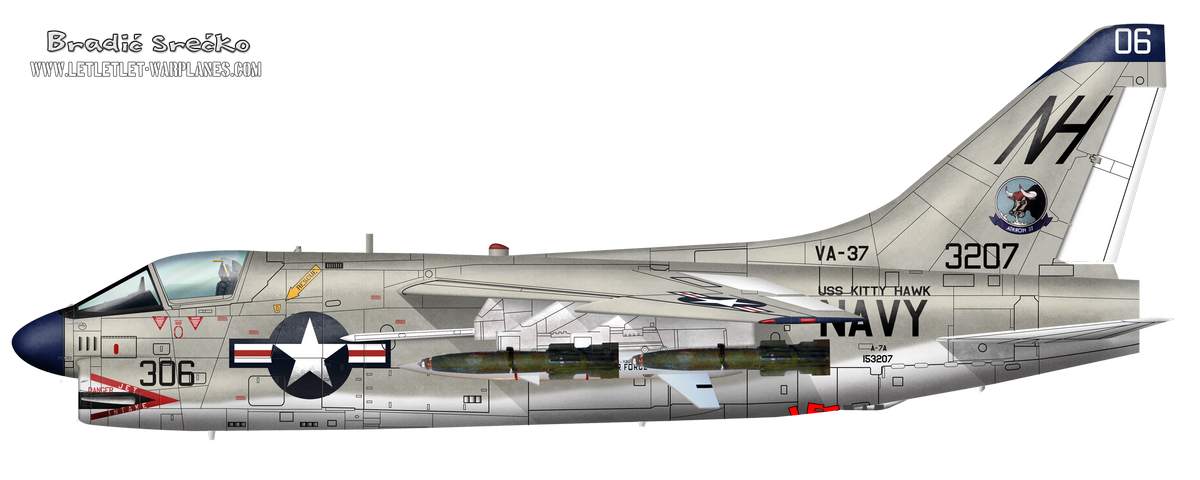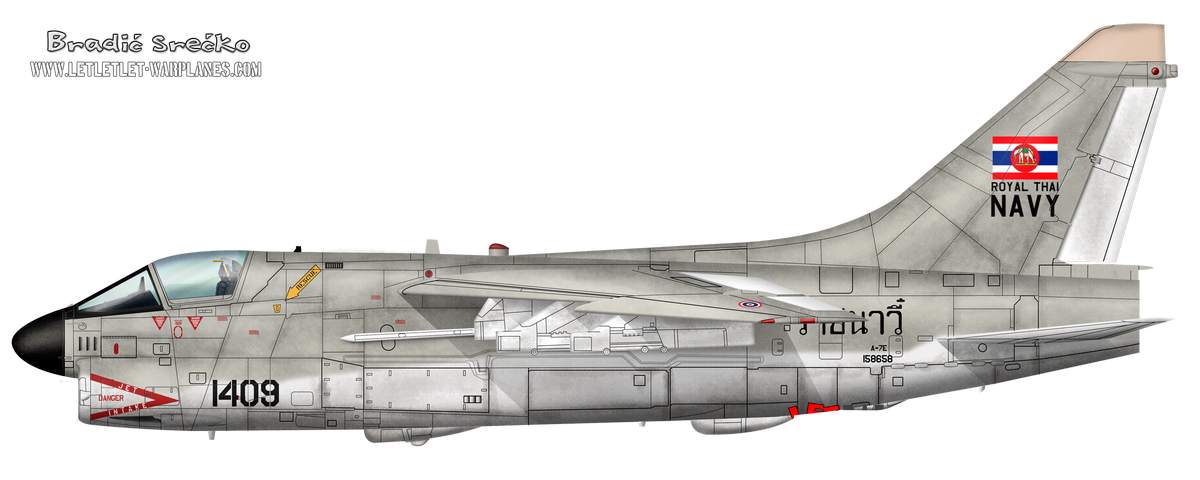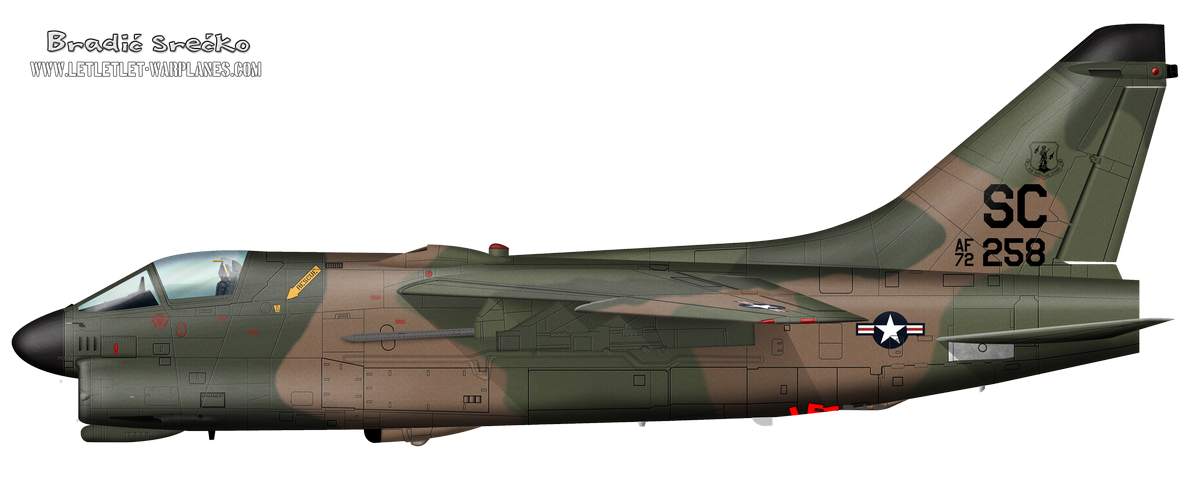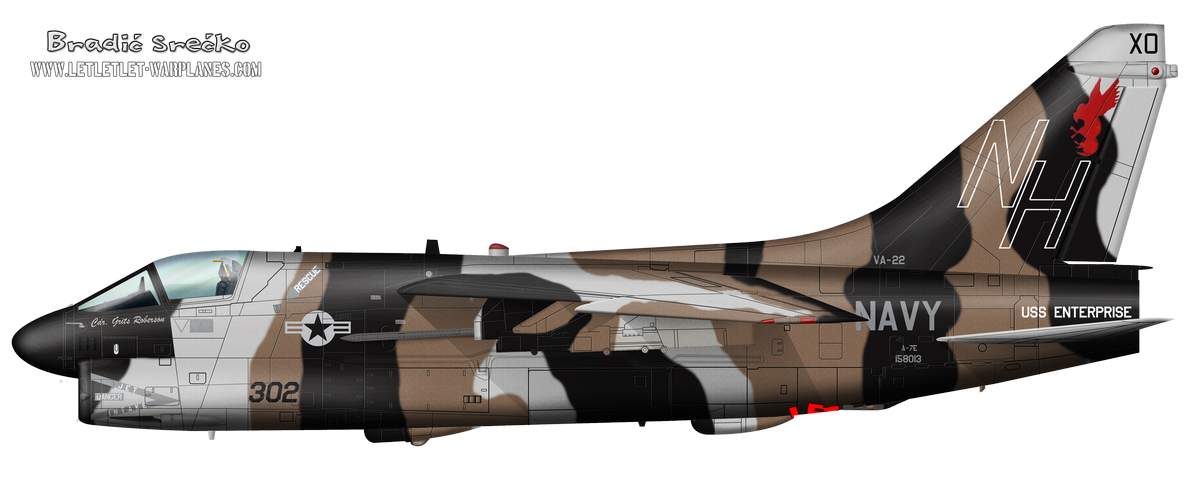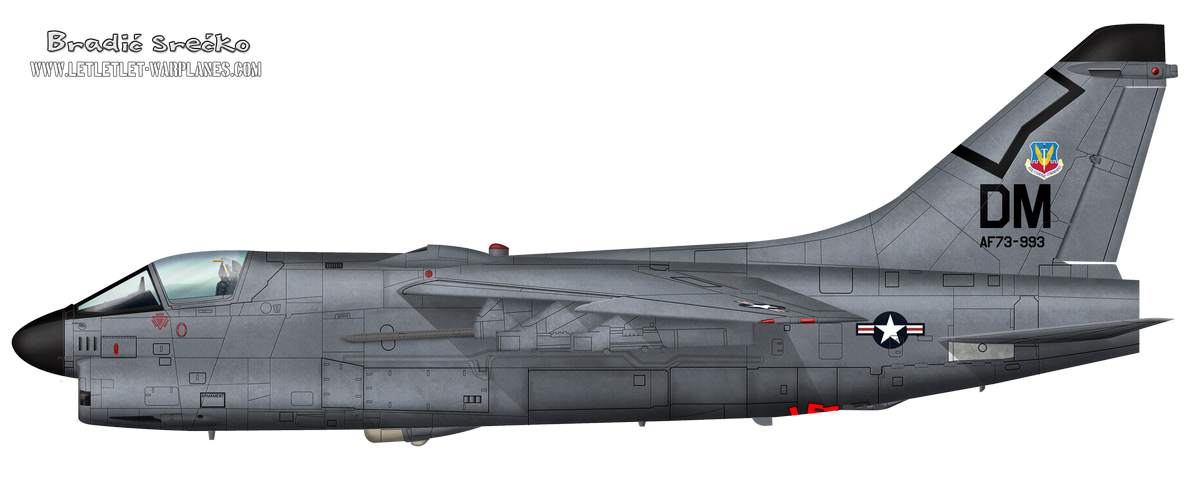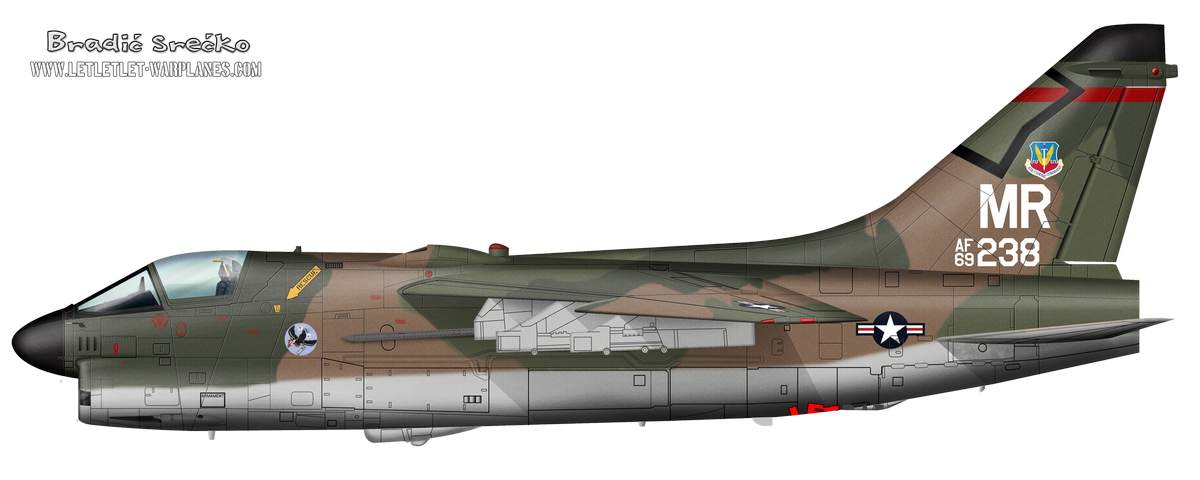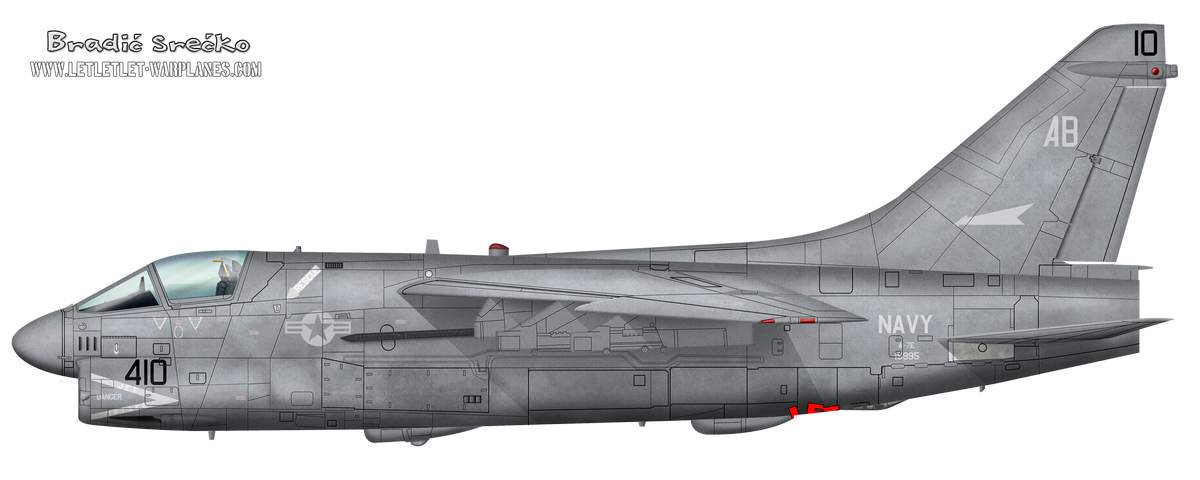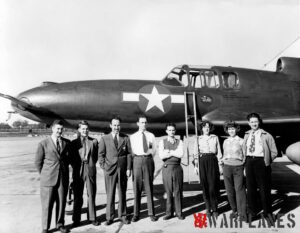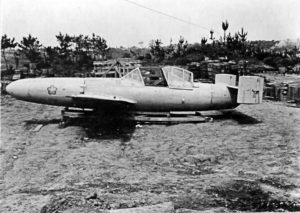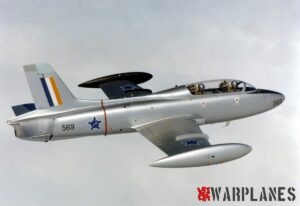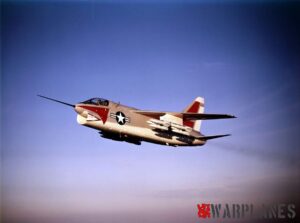LTV A-7 Corsair II
When the U.S.A. entered the Vietnam war with the standard carrier-based U.S. Navy attack plane Douglas A-4 Skyhawk, they discovered that it was too small with a too limited range for this war. A successor was planned with double the A-4’s bomb load at a double range. Aircraft type finally selected was the A-7 from Vought, later renamed into Ling-Tempco-Vought, or L.T.V. It was developed in a very short time since it was a more or less smaller and lighter subsonic development of the famous F-8 Crusader supersonic naval fighter although it was of course a totally new design. The A-7 fully met its expectations in the Vietnam war and continued to serve at the U.S. Navy as a standard attack plane. Although officially known as ‘Corsair II’ the pilots flying it called it affectionately the SLUF, an abbreviation of ‘Short Little Ugly Fellar’. Also the U.S.A.F. used a modified version of the A-7.

The A-7 Genesis
With the Douglas A-4 Skyhawk the U.S. Navy had an excellent fighter bomber. Initially it was developed to deliver a tactical nuclear bomb on coastal targets. It was fully suitable for this role. However, for the ‘limited war’ in Vietnam and armed with old-fashioned ‘iron’ bombs it showed its shortcomings of limited load-carrying capabilities and a limited range. It could be refuelled in-flight, but it meant the fuel tankers had to stay relatively close to enemy terrain.
As an answer, new specifications were drawn up for a Skyhawk successor and in 1962 the U.S. aircraft industry was invited under the project name VAX to submit design proposals. Douglas, Grumman, L.T.V., McDonnell and North American all submitted a proposal. To save precious time the Chief of Naval Operations set up the Sea Based Air Strike Forces (SBASF) Study Group to come up with a final solution to produce a new attack plane in the shortest possible time. SBASF came to the conclusion that supersonic speed was not necessary if low-level penetration missions were the most important. Under the new project name VAL (Navy Attack-Lightweight) new requirements were set up by the end of 1963 for a small and relatively cheap and easy to produce aircraft that could carry a large external loads over a long distance. The SBASF preferred a version based on an already existing type, rather than the development of a new type.

From a number of projects, the Vought proposal was finally selected. The Vought design for the new attack plane, carrying the designation A-7, was roughly based on the already existing F-8 Crusader fighter. In fact, the A-7 was a smaller and lighter redesign of the F-8 fitted with a Pratt & Whitney TF30 turbofan jet engine. The wing was totally new with six ‘strong point’ for the offensive load. The F-8 had a variable incidence wing to give it a lower approach speed on landing, but for simplicity this was not used on the A-7.
In June 1964 a full-scale mock-up was presented for inspection and all full engineering design work was completed in January 1965. Under a tight time-schedule three pre-production YA-7A’s were ordered. The first YA-7A flew first on 27 September 1965 and although it crashed a few months later, the evaluation program went so smoothly that a year later the first production models were ready to enter operational testing. In a very short period of time a new attack fighter was developed and built that would soon earn itself a reputation for good handling properties, excellent performances, reliability and ease of maintenance! Final service would not be limited to the U.S. Navy alone. Also Air National Guards and the U.S.A.F. used it operationally and a number were also exported to other countries (Greece, Portugal and Thailand). Over the years, a total of more than 1500 of various A-7 versions were manufactured.

While the YA-6A prototypes were extensively tested, early production A-7A’ started to roll from the productions lines and just under one year after the type’s first flight the first A-7A evaluation models were delivered to the U.S. Navy. They were tested at Squadron VA-174 based at Cecil Field in Florida and already in November 1966 the first flight testing on board of an aircraft carrier (USS America) took place. Carrier launches with full loads were made in 1967 on the aircraft carrier USS Independence and without serious teething problems the A-7A was introduced operationally as standard U.S. Navy attack plane. By August 1967 Vought had already delivered 125 A-7A’s. Based on the practical experiences the first modifications became necessary with as first the fitting of an ECM blister just above the rudder above the exhaust pipe. The A-7A’s also received as defensive armament a pair of Sidewinder AAM’s.
With its underwing load of 6804 kg (15,000 lbs) it fully met its expectations and newer, more improved versions soon followed. Officially named the ‘Corsair II’ after its famous predecessor it was by its crews better known as the SLUF, while ‘Sandy’ or ‘Little Hummer’ were also used as a nickname. With its raison d’être being dictated by the conditions of the Vietnam War, it was soon ready to join this conflict…..
Atlantic Fleet Squadrons
VA-12 Clinchers was formed on 12. May 1945 and were based on NAS Cecil Field. Unit started with piston fighters and in December 1970 they were converted from A-4C to A-7E. At the time they operated from USS Independece (CV 62) and USS Dwight D. Eisenhower (CV-69).
Va-15 Valions starts its life at 10. December 1942 and first plane to operate was SBD Dauntless. Original designation was VT-4 and it was renamed into VA-15 in 1948. A-7B replaced A-4 at 1. June 1969 and at October 1975 A-7E replaced previous version. Corsair II end it service in unit in 1986 when was replaced with F/A-18 Hornet.

VA-37 Bulls was established at 1. July 1967 and from the very start they operated Corsairs, that was A-7A version. After operations over North Vietnam it was turn back to Cecil Fields in September 1969.In April 1970 they was abroad USS Saratoga (CVA-60) and they was return on Yankee Station in May 1972 and engaged in following three months in the combat over Vietnam. They return to Cecil Field and begun conversion to A-7E. Now as part of the CVW-6 they continue operations from USS Forrestal (CV-59).
VA-46 Clansmen was first attack jet squadron of the Navy and they was established at 1. July 1955 at NAS Cecil Field, Florida. They was converted to the A-7B on 1. June 1968 and was first A-7 unit to operate in Mediterranean in 1969.In February 1970 they received new A-7E model.
Va-66
Into war in Vietnam
When the operational testing of the first batch of A-7A’s was successfully completed, it was time to use it into the Vietnam war. In November 1967 U.S Navy attack squadron VA-147 was the first one flying missions with the A-7A against bridges and highways in the Vinh area near the Mekong delta . In a period of two months the USS Ranger based squadron flew 1400 further combat sorties for the loss of one A-7A (which was downed on 23 December). More A-7’s followed to the battle scene and over the period 1967-1971 no less than 27 U.S. Navy squadrons were equipped not only with the A-7A, but also with the improved B,C and D versions. The were all intensively used for bombing attacks and ground support in Vietnam.

Basically we can even say that without the Vietnam war, there would have been NO A-7! In the Vietnam war, the U.S. Navy lost a total of 98 A-7’s during military operations.
The success of the A-7 in the Vietnam war was so great that also the U.S.A.F. became interested in this type. In 1970 they took delivery of the first improved A-7D, fitted with a more powerful Allison TF41-A-1 turbofan engine. In fact, this was a licence-built version of the Rolls Royce Spey engine (as used in the U.K. F-4K Phantoms and the Hawker Siddeley Buccaneer!). It had a single 20 mm Vulcan rotary gun. Also the U.S.A.F. Corsair II’s were used in the Vietnam area where the 354th TFW started in September 1972 with two squadrons of A-7Ds from Korat airbase in Thailand as part of Operation Cornet Dancer. Basically the A-7D replaced not only the A-1 Skyraider, but also other types like the F-100 Super Sabre and the F-105 Thunderchief.

The A-7D was not only used for direct bombing and ground attack missions, but it was also actively used for SAR missions in cooperation with rescue helicopters. The A-7D’s used for this purpose were known as ‘Sandy’s’ and their task was to locate downed pilots on enemy occupied territory and make a safe retrieval by helicopters possible by providing cover. In fact, the A-7D took over this task from the A-1 Skyraider. The YA-7D made its first flight on6 April 1968 and total production for the U.S.A.F. was 459. In fact, the replacement of the original TF30 engine by the much more powerful and fuel-efficient TF41 gave the Corsair II much better performances with a greater range on the same amount of fuel!
All A-7 operations in Vietnam came to an end when U.S. forces left this country in 1973. but the A-7 was one of the last planes flying missions until the very last day! The USAF A-7D flew an impressive total of 12,928 combat sorties during the Vietnam war with only six losses. Again it proved the soundness of the A-7 design since this was the lowest of any U.S. fighter losses in this conflict. In the total amount of bombs dropped on Hanoi, only the B-52 scored better than the Corsair II, but the A-7 dropped more bombs with greater accuracy than any other U.S. attack plane.
One of the aftermaths in South East Asia when U.S. forces left Vietnam was flying combat sorties in Cambodia against the Red Khmer armed forces. Also here ‘good old’ 354 TFW was active with the A-7D. Later they were relieved by the 355 and 23 TFW; all based at Morat, Thailand. The Operations lasted until August 1973.

After the Vietnam war
When the A-7D’s from the U.S.A.F. returned from South East Asia, a number found their way to various Air National Guard units. However, the SLUF far from retired; it also saw action in various other armed conflicts!
Grenada:
When after a military coupe Cuban forces started to arrive at this tiny island, U.S forces interfered in October 1963 with a military invasion know as Operation Urgent Fury. U.S. Navy A-7E squadrons VA-15 and VA-87, based on USS Independence, provided top cover during this operation. Also the U.S. National Guard provided a number of A-7D’s for ground attack missions. Main military aerial operations were around the airports and some military barracks and the conflict was over in just a few days with as tragic list:
19 U.S soldiers killed and another 115 injured
45 Grenada soldiers killed and 385 wounded
Further, 25 Cuban soldiers were killed and 59 wounded with 638 taken prisoner.
There were no losses of U.S. aircraft used in this small conflict.
Lebanon:
As a multinational peace keeping force in Lebanon in 1983 also U.S. forces were involved with U.S. Navy A-7E’s providing cover from USS Independence. They were from squadrons VFA-15 and 87. Although most military actions were performed by ground troops, Syrian-supported groups equipped with anti-aircraft missiles managed to shoot down a patrolling Grumman A-8 Intruder and an A-7E. The Corsair II was flown by Commander Edward Andrews. After a Strela 2 shoulder-launched missile placed a direct hit he managed to fly away in his damaged plane until he was over coastal waters where he ejected. He was rescued by a ‘friendly’ Lebanese fishing boat. The two-man crew of the A-6 Intruder was less lucky; the pilot was killed while his navigator was captured by Syrian troops after his ejection. As far as known, A-7’s did not drop any weapons in this conflict.
Libya:
When U.S. military ships patrolled in the disputed Gulf of Sidra near the Libyan coast USS Saratoga based A-7’s attacked in the spring of 1988 with HARM missiles Libyan anti-aircraft missile sites . This was a retaliation of an earlier action of Libyan defences when they fired SAM missiles at F-14 Tomcat fighters. As far as known the F-14’s escaped without damage but the damage to the Libyan SAM batteries by radar-homing HARM missiles must have been far greater!

Iraq:
During Operations Desert Shield and Desert Storm no U.S.A.F. A-7’s were used (they preferred to use the A-10). However, U.S. Navy A-7E’s on board of USS John F. Kennedy made combat sorties against Iraqi targets, both in occupied zones in Kuwait and in the Iraqi mainland. The A-7E’s were from squadrons VA-46 and 72. These were the only A-7’s used in this conflict. In August 1990 these aircraft also were the last Corsair II’s making combat missions. During Operation Desert Storm the A-7E’s were operated both by day and by night using a variety of weapons including laser-guided bombs, TV-guided Walleye glide bombs, unguided bombs and HARM missiles. The A-7E’s were also occasionally used for in-flight refuelling of other planes.
Variants and numbers produced
After introduction of the A-7, the following versions were built:
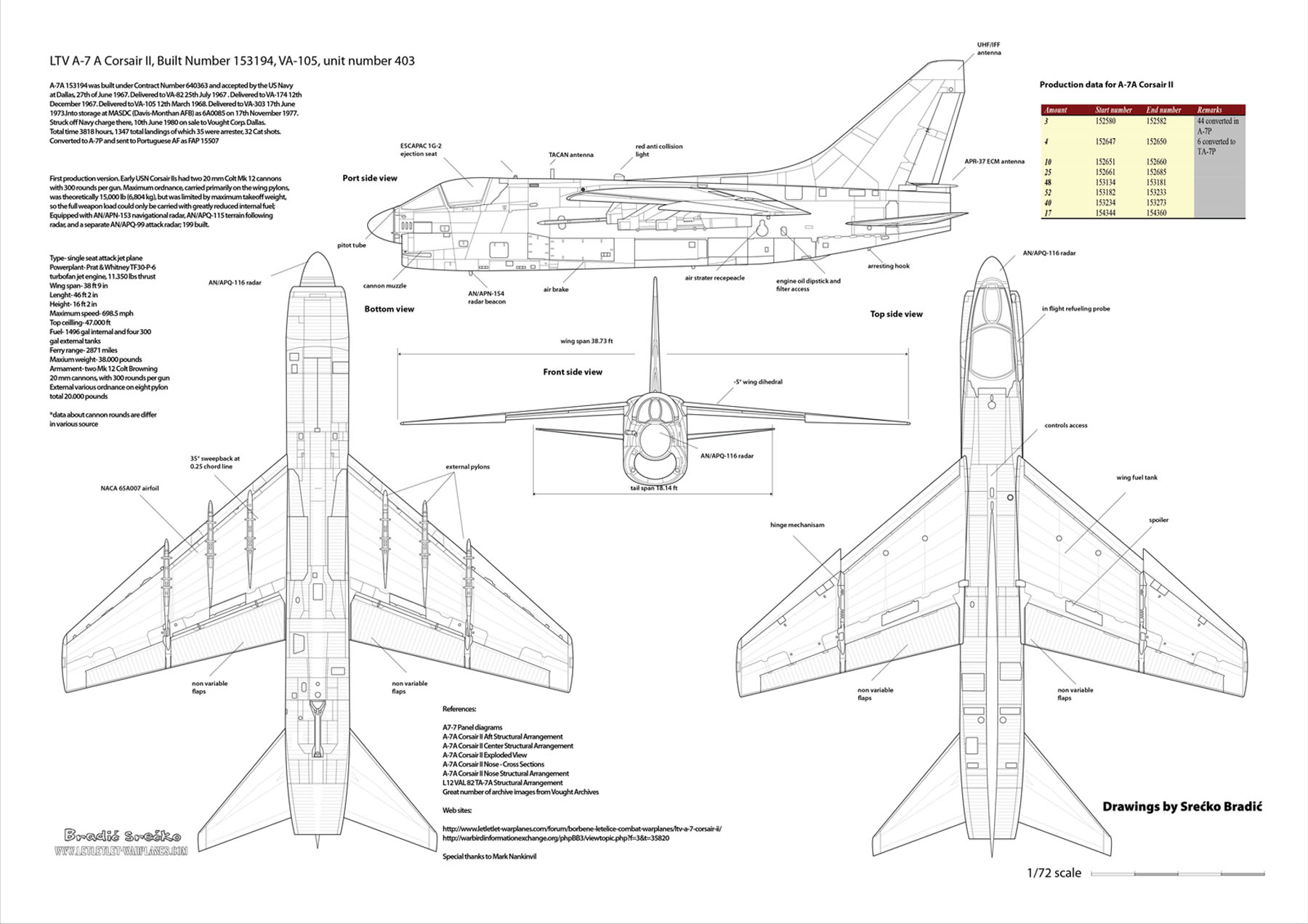
A-7A
The initial U.S. Navy attack version with a TF30-P-6 jet engine giving 5250 kg thrust..
Production including the three YA-7A prototypes was 199 aircraft.
A-7B
Grossly similar to previous version, but fitted with a TF30-P-8 engine up-rated to 5534 kg.
First flight made on 6 February 1968. Total production 196 with 24 aircraft converted to TA-7C trainer.
A-7C
Originally a two-seat version with a fuselage lengthened to 14.73 m . Designation was later retrospectively used for 67 A-7E’s with the TF30-P-8 engine; 36 were later converted to TA-7C trainers.
TA-7C
Designation for 24 A-7B’s and 36 A-7C’s converted to two-seat conversion trainers. First flown on 17 December 1976 and in service at VA-122 and 174.
A-7D
U.S.A.F conversion of the Corsair II with a TF41-A-1 Spey engine, 20 mm Vulcan gun and in-flight refuelling probe. First YA-7D made it first flight on 6 April 1968, still fitted with a TF30 engine. Production was 459; of which 383 were modified to carry the Pave Penny laser pod under the air duct. Arrester hook and folding wings were retained on this version!
TA-7D
Early designation for A-7K.
A-7E
U.S. Navy version fitted with TF41-A-2 Spey engine and in-flight refuelling probe. First A-7E, still fitted with a TF30-P-8 engine, made its first flight on 25 November 1968. Total production was 596. Of these 67 were still fitted with the TF30-P-8 engine and re-designated as A-7C. The prototype YA-7E was a re-designation of the Vought V-159 YA-7H.
KA-7F
Proposal for a carrier-based tanker version with 8467 kg internal fuel and an additional 3266 kg in four underwing tanks. Not built.
A-7G
Projected export version for Switzerland based on the A-7D with a TF41-A-3 engine. Two A-7D’s were used for demonstration, but the order was not placed and the version never built.
YA-7H
Original designation for the two-seat Vought V-159 demonstrator. Re-designated as YA-7E and converted from A-7E.
A-7H
Land-based version (but with folding wings and arrester hook) for the Hellenic air force. First flown on 6 May 1975. Production 60 of which 1 was converted as a dual-seat trainer as TA-7H.

TA-7H
See above
A-7J
One aircraft from A-7E inventory specially instrumented for testing purposes.
A-7K
Two seat version of the A-7D for service at the Air National Guards. First prototype converted from an A-7D made its first flight on 29 October 1980. Total of 30 built with another 12 converted from the A-7D
A-7P
Designation for ex-U.S. Navy A-7A’s fitted with the TF30-P-408 engine and refurbished for use by the Portuguese air force. In total 44 were delivered over 1981/1982. Six more ex-U.S. Navy refurbished A-7A’s were delivered as two-seaters as TA-7P

The Corsair III
A highly modernized version with a General Electric F110-GE100 of 7575 kg dry thrust, to be augmented to a further 12,111 kg with the use of an afterburner and up-to-date avionics and weapon systems was introduced in 1984 during the Farnborough airshow. It was offered as a rebuild from machines stored at the MASD at Davis Monthan. It was planned to give the type a new life as attack plane for the Air National Guard. It was also hoped that this supersonic development could be sold to foreign users as an economic alternative for the F-16 attack versions and as successor for the many F-5 Freedom Fighters still in use at that moment.
It remained a project……

The A-7X
A supersonic fully area-ruled version of the Corsair II was already announced in an early Vought brochure from 1965. It was planned as a Mach 2 air superiority fighter and attack plane fitted with a much more powerful ‘Super Spey’ jet engine. It was never built.
Export versions
Although the A-7 was not supersonic, it was still regarded as a very interesting export product and Vought/L.T.V. agents did all they could do to sell the type outside the United States. The first country interested was Switzerland. A special version was offered as the A-7G, to be fitted with the TF41-A-3 Spey engine. Two A-7D’s were converted as demonstration aircraft for the Swiss air force, but eventually an order was not placed. Instead, the Northrop F-5 was selected.

L.T.V. had more success in Portugal. The Portuguese air force ordered 44 A-7P’s with an additional six TA-7P’ dual seat trainers as a replacement for their North American F-86 Sabre fighters. They were refurbished ex-U.S. Navy A-7A’s fitted with the more powerful Spey engine and with ‘customer-demanded’ avionics. They were delivered over 1981/1982 and became a familiar sight in European skies since they regularly visited airshows, NATO squadron rotations and NATO exercises. The Portuguese Corsair II’s were used for 18 years and over this period 14 were lost in accidents. Lack of spares and increasing maintenance problems finally resulted in the remaining fleet being grounded and retired in the spring of 1999. They were replaced by the General Dynamics F-16.
The A-7 saw another European customer: the Hellenic air force. Greece ordered 60 aircraft as A-7H. One of these was converted in a two-seater as TA-7H. Just like the Portuguese Corsair II’s they were refurbished ex-U.S. Navy machines. They were regularly updated, and a number had the original TF30 engine later replaced by the Allison TF41. Also avionics were up-dated. The A-7H is still operational at the Hellenic air force with an expected retirement in 2017. They are the only Corsair II’s still operational! The A-7H’s are flown by the 116th Fighter wing of the Hellenic air force, based at Araxos.

The third country receiving the A-7 was Thailand. They purchased in the early nineties 14 A-7E’s and 4 TA-7C’s refurbished from ex-U.S. Navy machines. They were used by the 1st wing of the104th ‘White Shark’ squadron of the Thai naval air force based at the military section of U-Tapao International Airport near Bangkok. They were used for coastal patrol missions. Since summer 2007 they are not any longer operational, but they are still maintained for possible use in the future. However, it is not very likely they will ever fly again!
For the rest, L.T.V. was not very lucky with the sale of export machines. There were plans to have the A-7 licence-manufactured in Canada, but here they finally selected the Northrop F-5. Portugal and Greece were the only NATO countries with the A-7, although it was offered to other NATO countries as well. In the Netherlands it was one of the candidates to replace the F-84F Thunderstreak fighter-bomber, but the KLu (Koninklijke Luchtmacht) finally selected the Canadian built version of the F-5. Also Norway made the same choice.
Pakistan also showed great interest in the A-7, but export to this country was banned by the U.S. government because of its nuclear program, that finally resulted in a nuclear weapon. Apparently U.S. government did not like to see their Corsair II’s being armed with a Pakistani nuclear bomb for possible use against India!

Phase out
The U.S. Navy and the U.S.A.F. started to phase out its Corsair II’s in the late eighties. When F-16’s began to replace the A-7’s at the Air National Guards they were withdrawn from operational service and ended their days at the MASD at Davis Monthan. The last ANG Corsair II’s were retired in 1993. Final phase out of the U.S. Navy A-7’s took place shortly after the Operation Desert Storm in May 1991.
The A-7’s from Portugal and Thailand are all phased out; the only A-7’s still operational are still flying at the Hellenic air force.
Technical details A-7E version
Powerplant: 1 × Allison TF41-A-2 non-afterburning turbofan engine, 15,000 lbf (66.7 kN) thrust
Dimensions:
-Length: 46 ft 2 in (14.06 m)
-Wingspan: 38 ft 9 in (11.8 m)
-Width: 23 ft 9 in (7.24 m) wings folded
-Height: 16 ft 1 in (4.9 m)
-Wing area: 374.9 sq ft (34.83 m2)
Airfoil: NACA 65A007 root and tip
Weights:
-Empty: 19,127 lb (8,676 kg)
-Max take off: 42,000 lb (19,050 kg)
Fuel capacity: 1,338 US gal (5,060 l; 1,114 imp gal) internal
Performances:
-Maximum speed: 600 kn (690 mph; 1,111 km/h) at sea level
562 kn (1,041 km/h; 647 mph) at 5,000 ft (1,524.0 m) with 12x Mk82 bombs
595 kn (1,102 km/h; 685 mph) at 5,000 ft (1,524.0 m) after dropping bombs
-Range: 1,070 nmi; 1,231 mi (1,981 km) on maximum internal fuel
-Ferry range: 1,342 nmi; 1,544 mi (2,485 km) with maximum internal and external fuel
-Sustained manoeuvring performance:
5,300 ft (1,615.4 m) turning radius at 4.3g and 500 kn (930 km/h; 580 mph) at an All Up Weight (AUW) of 28,765 lb (13,048 kg)
Take-off run: 1,705 ft (519.7 m) at 42,000 lb (19,000 kg)
Crew: 1

Armament
Guns: 1× M61 Vulcan 20 mm (0.787 in) rotary cannon with 1,030 rounds
Hardpoints: 6× under-wing and 2× fuselage pylon stations (for mounting AIM-9 Sidewinder AAMs only) with a capacity of 15,000 lb (6,803.9 kg) total capacity with provisions to carry combinations of:
Rockets: 4× LAU-10 rocket pods (each with 4× 127 mm (5.000 in) Mk 32 Zuni rockets)
Missiles:2× AIM-9 Sidewinder AAM; 2× AGM-45 Shrike Anti-radiation missile (ARM); 2× AGM-62 Walleye TV-guided Glide bomb; 2× AGM-65 Maverick; 2× AGM-88 HARM; 2× GBU-8 HOBOS electro-optically guided Glide bomb
Bombs:
Up to 30× 500 lb (226.8 kg) Mark 82 bombs or Mark 80 series of unguided bombs (including 6.6 lb (3 kg) and 31 lb (14 kg) practice bombs)
Paveway series of laser-guided bombs
Up to 4× B28 nuclear bomb/B57 nuclear bomb/B61 nuclear bombs
Other: up to 4 × 300 US gal (1,100 l), 330 US gal (1,200 l) or370 US gal (1,400 l) drop tanks
Avionics
AN/ASN-90(V) Inertial reference system
AN/ASN-91(V) navigation/weapon delivery computer
AN/APN-190(V) Doppler groundspeed and drift detector
Texas Instruments AN/APQ-126(V) Terrain-following radar (TFR)
AN/AVQ-7(V) Head Up display (HUD)
CP-953A/AJQ solid state Air Data computer (ADC)AN/ASN-99 Projected Map Display (PMD)
(Source: Wikipedia)

Survivors
When the Corsair II was phased out at the U.S. armed services, a large number of planes was donated to various aviation museums as exhibit and to airports/airfields as a gate guard. In total, more than 50 A-7’s are still existing! Most are exhibited in the U.S.A., but even in Europe it can be seen: the Polish aviation museum at Krakow has on display the ex-Portuguese air force A-7P no. 5502.

Conclusion
Although the A-7 Corsair II was never regarded as a very sensational fighting plane with superior performances, and in spite of having remained more or less ‘on the background’ of aviation history, this is quite undeserved. The ‘Short Ugly Little Fellar’ just did the work it had to do under war conditions when it became operational and it did this in a much better and efficient way than the other types used in the Vietnam war for attack bombing like the F-100 Super Sabre and the F-105 Thunderchief. Also in later conflicts, even in Operation Desert Storm it showed to be fully capable to fulfil its missions, in spite of its age!
Srećko Bradić

